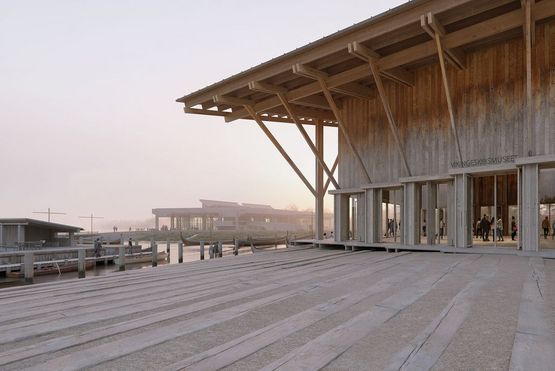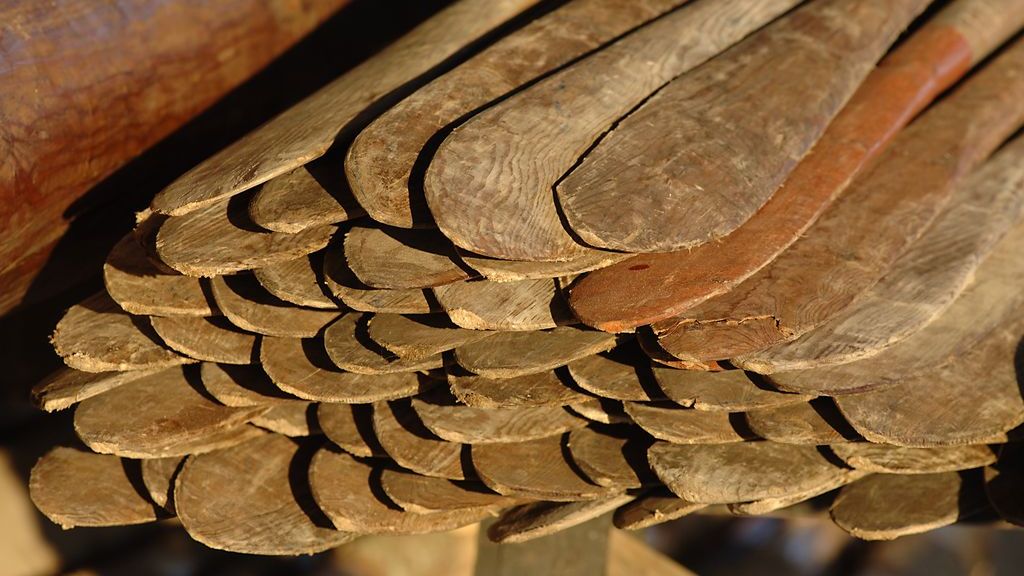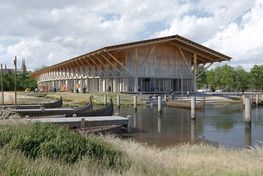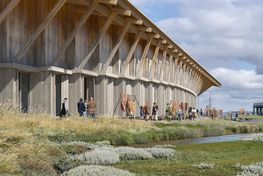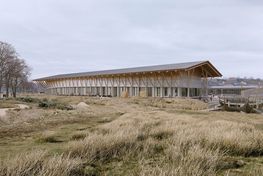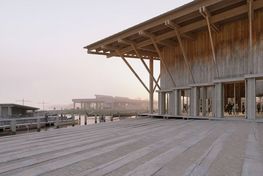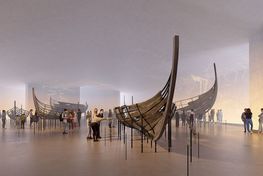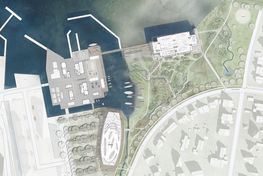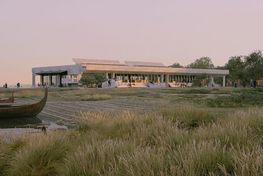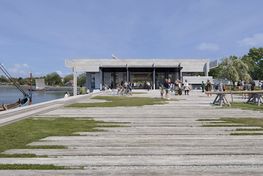Just three weeks have passed since the Viking Ship Museum’s response team secured the 1,000-year-old ships in the Viking Ship Hall from the threat of a storm surge.
“We recently had extremely bad weather which, once again, underlined the need for new surroundings for the Viking ships in Roskilde. Therefore, it’s really good news that the project has taken this vital step forward. Because in the future we will also need to look after the unique cultural heritage these ships represent, and exhibit the ships so that the public can learn about a vital period in our history”, explains Minister for Culture, Jacob Engel-Schmidt.
Maritime crown jewels protected from climate change
In choosing a winner of the architect competition, the first foundation for a permanently climate-resilient New Viking Ship Museum has been laid. In total, the new museum has received 310 million kroner in funding to secure the Viking ships.
“Today, it’s with great relief that we can present the new sustainable building, which will protect the irreplaceable Viking ships for the future. The new home for the ships will lie at the highest point on the museum site, at a safe remove from the power of the sea and the ships will be protected from the destructive effects of natural daylight. At the same time, the winning project also suggested a really beautiful transformation of the existing Viking Ship Hall, which greatly respects its architectonic qualities. The winning project fully supports the museum’s maritime narrative by including a public area, which can also be used as a slipway for the museum’s ships”, tells the Viking Ship Museum’s director, Tinna Damgård-Sørensen.
The new building doesn’t shy away from what it is, namely, a home for ships from the Viking Age. The new building is designed with visible structural details in wood in a rhythm that mirrors the current Viking Ship Hall.
Architects using nature as the unifying force
The new home for the Viking ships in Roskilde will be created by Lundgaard & Tranberg Architects.
“As architects, this is a dream come true. We have the opportunity to work in the borderland between both protecting and renewing the unique cultural heritage, which both the Viking ships and the Viking Ship Hall represent. From the outset, we have been focused on finding the obvious and strong solution, which can both engage the potential this special place has while preserving free access to the fjord for the general public. We have positioned the new museum building in such a way that it unites the three very different groups of buildings and at the same time, creates space and a natural transition to the landscape between them. It creates a unified museum experience with the fjord and the beach meadow – indeed, with nature as the great, unifying force,”, says Lene Tranberg.
She is partner and founder of Lundgaard & Tranberg Architects, who have designed the building which will come to house this irreplaceable cultural heritage, Viking ships from the late Viking Age, which were found in Roskilde Fjord over 60 years ago.
The new building for the ships will be constructed in wood. This is a material, which connects to the past via the houses and ships of the Viking Age. It also creates a connection to the modern buildings on the Museum Island and life at the harbour.
Timeline for the creation of the New Viking Ship Museum
Timeline:
2023: Architect competition
2024 – 2025: Local plan and project planning
2025 – 2027: Construction of the new building for the ships and an arrivals hall
2028: The Viking ships move into the new building
2028 – 2030: Transformation of the Viking Ship Hall and landscape design
The fjord landscape, the town and the architecture combined
The new building will be constructed along the stream of the spring, which runs from Roskilde Bypark and down to the fjord. In that way, a clear and aesthetic connection will be created to the town and Roskilde cathedral, the foundations of which were laid by the Vikings who sailed the Skuldelev Ships 1,000 years ago.
“The winning entry from Lundgaard & Tranberg Architects creates a fantastic connection between the new building for the Viking ships, the current Viking Ship Hall, Roskilde town and the landscape. We will get a large beach meadow, which can cope with water and invite local flora into the area and which will fit in with the surrounding fjord landscape. In that way, it’s an architectonic work, whose qualities lie not just in the actual building but which are expressed in unison with the landscape, nature, history and people,” tells chairman for the selection committee and Mayor of Roskilde, Tomas Breddam.
The architect’s recreation of a maritime moment in time
Even though it’s a large building, it almost humbly steps to the side and gives space to the dramatic nature around the fjord and all the activities the Viking Ship Museum already has.
“Roskilde Fjord is a unique fjord landscape in Denmark. In the Viking Age, the fjord was the link between Roskilde town and seven seas. It was vital for us that the new museum building would contribute to visitors noticing that connection. As soon as you arrive, you meet a long, slightly curved building, which leads towards the fjord and the entrance to the museum. The elongated shape of the building enhances the exhibition of the five Viking ships as a collective fleet with their natural orientation towards the sea. The space around the ships is airy and positions them as the primary museum experience,”, tells partner and architect, Malene Hjortsø Kyndesen fra Lundgaard & Traneberg Architects.
The new building’s northern side will have an attractive open space, where you can step outside to a view over the Museum Harbour, where the original archaeological ship-finds are brought to life when the reconstructed Viking ships sail out with guests, volunteers and museum staff.
The New Viking Ship Museum has received 310 million kroner in total:
Support from private foundations
Villum Fonden have supported the project with 60 million kroner
Augustiunus Fonden have supported the project with 50 million kroner
Aage og Johanne Louis-Hansen Fond have supported the project with 25 million kroner
State support for the New Viking Ship Museum
The Parliament has supported the project with 150 million kroner in a Financial Law Grant
Roskilde Municipality has supported the project with 25 million kroner
A new direction for Danish Architecture
The building to house the Skuldelev Ships steps gently aside on the site, preserving the view from the town to the fjord and doesn’t overshadow the existing architectonic structure by the fjord.
“The new Viking Ship Museum is a good example of a new direction, where architecture is much more than just designing buildings. Lundgaard & Tranberg Architects have presented an example of how architecture can help generate well-being, communities and support the cohesion between Roskilde town, coastal nature, the fjord and the existing architecture. The project also demonstrates how architecture can help in the move towards sustainability and in coping with the marked consequences of climate change,”, states Johnny Svendborg, one of the selection committee’s three architectural expert judges.
The new building for the Viking ships will be constructed in wood and therefore takes responsibility for the future. A large percentage of the materials will be bio-based, with the primary aim of minimising the building’s CO2 footprint from construction. The building’s geometry has been actively optimised during the design process in order to minimise the use of resources and with a focus on reducing the amount of building materials with a large climate footprint, such as concrete and unnecessary amounts of glass in the façade.
“The building is unpretentious in design with visible construction details and a materiality, which will acquire a natural patina. Its position and the organisation of the space will also help with a natural orientation towards the other attractions in the area. In this way, the proposal represents an architectonic direction, where the individual building isn’t as important as how the architecture can sustainably be a catalyst for a better connection between nature and people,” he continues.
The current Viking Ship Hall will be transformed
The unique Viking Ship Hall by Erik Christian Sørensen can look forward to a sustainable future with alterations that respect the building’s great architectonic qualities. The transformation will preserve 90% of the concrete and 80% of the bricks.
“The beautiful proposal for transformation of the Hall is clearly drawn with great respect for the original architectonic work. The alterations will be carried out with great empathy for the Viking Ship Hall’s tectonic qualities. The Hall will be of even greater benefit to Roskilde and will be revitalised as an architectonic masterpiece, which has been carried into a new time,” tells expert judge Mette Tony, who is an architect with Praksis Arkitekter and has had focus on the project’s brief with conservation and transformation.
A new meeting place in Roskilde
In the proposal, the entire façade of the Viking Ship Hall which faces towards the town will be rebuilt with a new, extensive transformation, running the entire length of the building and which will extend a clear invitation to those passing by.
“We have tread gently with our transformation of the Hall. It’s been extremely rewarding to work with such an important architectonic building, which has a beautiful, very defined spatial structure with a clear hierarchy, which makes it possible to open the facades out towards the beach meadow in a way that is grounded in the building’s own logic,” explains partner and architect Malene Kyndesen from Lundgaard & Tranberg Architects.
In addition, the winning proposal opens the western side of the Hall up with a large, public fjord plaza, which will also be used as a slipway for the museum’s ships. Here by the fjord, the public areas and the museum blend together in a new way.
The Hall will thus relinquish the ships but will take on a new function, inviting the public even closer to the maritime life by the fjord and the sea, which has been the lifeblood of people for thousands of years.
The winning project:
The studio Lundgaard & Tranberg Architects have had a long career with aesthetically attractive and inventive buildings. These include Skuespilhuset in Copenhagen, Tietgenkollegiet in Ørestad, Kannikegården in Ribe and Frihedsmuseet at Kastellet in Copenhagen.
The team behind the winning project are:
Lundgaard & Tranberg Architects
Marianne Levinsen Landskab
Christoffer Harlang Architects (Transformation expert)
Aaen Engineering (Sustainable leadership)
Niras Engineering (Engineering Services)
JAC Studios (Exhibition architecture)
The winning entry and the other proposals for the New Viking Ship Museum will be exhibited in the Viking Ship Hall from Friday January 12th until Sunday January 28th 2024.
